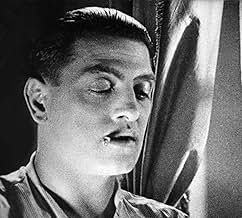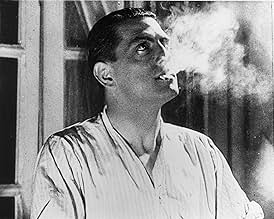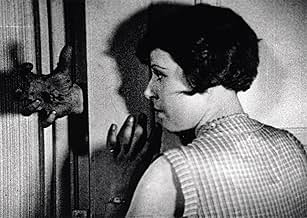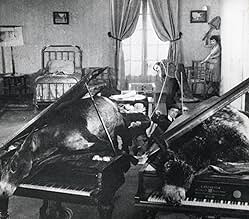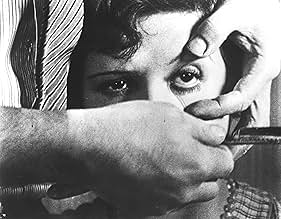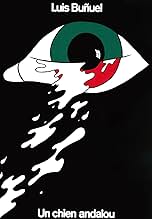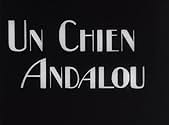Un chien andalou
- 1929
- Tous publics
- 16min
NOTE IMDb
7,6/10
56 k
MA NOTE
Ajouter une intrigue dans votre langueLuis Buñuel and Salvador Dalí present 16 minutes of bizarre, surreal imagery.Luis Buñuel and Salvador Dalí present 16 minutes of bizarre, surreal imagery.Luis Buñuel and Salvador Dalí present 16 minutes of bizarre, surreal imagery.
- Réalisation
- Scénario
- Casting principal
Pierre Batcheff
- Man
- (as Pierre Batchef)
Simone Mareuil
- Young Girl
- (as Simonne Mareuil)
Luis Buñuel
- Man in Prologue
- (non crédité)
Pancho Cossío
- Stroller
- (non crédité)
Salvador Dalí
- Seminarist
- (non crédité)
Juan Esplandiu
- Stroller
- (non crédité)
Robert Hommet
- Young Man
- (non crédité)
Marval
- Seminarist
- (non crédité)
Fano Messan
- Hermaphrodite
- (non crédité)
Jaume Miravitlles
- Fat Seminarist
- (non crédité)
Avis à la une
Even those who do not like Buñuel's "Un Chien Andalou" will probably never forget it once they see it. It's one of the weirder and more interesting films that you'll ever run across, and even aside from its significance, it would be worth seeing for the distinctive style and material.
It is also very well-crafted, despite its apparently chaotic narrative (or lack thereof). Even when it is impossible to attach meaning to some of the images, it seems clear that it has been filmed almost exactly as Buñuel and Dali intended. Even the music seems to have been chosen deliberately, and at times it complements the images surprisingly well.
While the exact meanings of many of the symbols are probably deliberately obscure, it strongly suggests some general themes such as desire, frustration, and the like. To attempt to analyze it carefully is almost certainly a mistake, and it is probably best taken as a dream or a dream-like series of events without the kinds of obvious connections that one might want to find.
Likewise, it's hard to determine just how good or how important it may be. The extreme disregard of cinema conventions is hard to evaluate now, in that the movie itself established some alternative conventions of a sort. The images themselves are often fascinating, sometimes unsettling or even off-putting, almost always interesting and suggestive.
Perhaps the one thing that can be said about such a movie without much risk of going astray is that almost anyone who has a real interest in cinema or cinema history will (or ought to) want to see "Un Chien Andalou" for himself or herself. Hearing it described by someone else really cannot adequately convey what it is like.
It is also very well-crafted, despite its apparently chaotic narrative (or lack thereof). Even when it is impossible to attach meaning to some of the images, it seems clear that it has been filmed almost exactly as Buñuel and Dali intended. Even the music seems to have been chosen deliberately, and at times it complements the images surprisingly well.
While the exact meanings of many of the symbols are probably deliberately obscure, it strongly suggests some general themes such as desire, frustration, and the like. To attempt to analyze it carefully is almost certainly a mistake, and it is probably best taken as a dream or a dream-like series of events without the kinds of obvious connections that one might want to find.
Likewise, it's hard to determine just how good or how important it may be. The extreme disregard of cinema conventions is hard to evaluate now, in that the movie itself established some alternative conventions of a sort. The images themselves are often fascinating, sometimes unsettling or even off-putting, almost always interesting and suggestive.
Perhaps the one thing that can be said about such a movie without much risk of going astray is that almost anyone who has a real interest in cinema or cinema history will (or ought to) want to see "Un Chien Andalou" for himself or herself. Hearing it described by someone else really cannot adequately convey what it is like.
Luis Buñuel and Salvador Dalí's "Un Chien Andalou" (1929) is not merely a film-it is a visceral assault on logic, a 16-minute plunge into the subconscious that redefined the boundaries of cinema. Emerging from the feverish collaboration of two avant-garde titans, this short film remains a cornerstone of surrealist art, blending dreamlike absurdity with shocking imagery to challenge the very notion of narrative coherence.
The film's structure mirrors the disjointed, irrational flow of a dream, eschewing traditional storytelling for a series of jarring vignettes. From the infamous opening scene-a cloud slicing the moon as a razor slits a woman's eyeball -to ants crawling from a man's palm and rotting donkeys draped over pianos, Buñuel and Dalí weaponize Freudian symbolism to evoke primal fears and desires. The creators famously declared that their only rule was to reject any rational explanation for the film's imagery, insisting that interpretation lies solely in the realm of psychoanalysis. This deliberate ambiguity transforms the viewer into an active participant, forced to confront their own subconscious reactions.
Shot on a shoestring budget over two weeks, the film's technical audacity remains striking. Buñuel's stark black-and-white cinematography and abrupt edits amplify the surreal atmosphere, while the use of a cow's eye for the slicing scene (to avoid harming an actor) underscores the visceral realism of the grotesque.
"Un Chien Andalou" defies categorization. It is neither a story nor a manifesto but a raw, unfiltered excavation of the human psyche. As Buñuel later quipped, "Nothing in the film symbolizes anything" , yet its power lies precisely in this refusal to conform. To watch it is to surrender to chaos-to let the ants crawl, the razors slash, and the donkeys rot. Nearly a century later, it remains a testament to art's ability to unsettle, provoke, and transcend.
A landmark of surrealism, "Un Chien Andalou" is essential viewing for anyone willing to brave its unnerving beauty. Just don't expect answers-only questions, writ large in blood and celluloid.
The film's structure mirrors the disjointed, irrational flow of a dream, eschewing traditional storytelling for a series of jarring vignettes. From the infamous opening scene-a cloud slicing the moon as a razor slits a woman's eyeball -to ants crawling from a man's palm and rotting donkeys draped over pianos, Buñuel and Dalí weaponize Freudian symbolism to evoke primal fears and desires. The creators famously declared that their only rule was to reject any rational explanation for the film's imagery, insisting that interpretation lies solely in the realm of psychoanalysis. This deliberate ambiguity transforms the viewer into an active participant, forced to confront their own subconscious reactions.
Shot on a shoestring budget over two weeks, the film's technical audacity remains striking. Buñuel's stark black-and-white cinematography and abrupt edits amplify the surreal atmosphere, while the use of a cow's eye for the slicing scene (to avoid harming an actor) underscores the visceral realism of the grotesque.
"Un Chien Andalou" defies categorization. It is neither a story nor a manifesto but a raw, unfiltered excavation of the human psyche. As Buñuel later quipped, "Nothing in the film symbolizes anything" , yet its power lies precisely in this refusal to conform. To watch it is to surrender to chaos-to let the ants crawl, the razors slash, and the donkeys rot. Nearly a century later, it remains a testament to art's ability to unsettle, provoke, and transcend.
A landmark of surrealism, "Un Chien Andalou" is essential viewing for anyone willing to brave its unnerving beauty. Just don't expect answers-only questions, writ large in blood and celluloid.
Good way to sample the filmography of Luis Bunuel is to begin with this surreal short. An excellent intro to Bunuel's more mature work because his films are full of bizarre images that began here. Un Chien Andalou(1929) like the rest of Bunuel's early works experiments with use of film image and surrealism. Illustrates the beginning of a career full of amazing, bizarre, and subversive films. Things could only get better for Bunuel's film career and they did.
Un Chien Andalou(1929) was an artful collaboration between two surrealistic masters in Luis Bunuel and Salvador Dali. These two artists were part of a surrealism movement in Spain that influenced the country's art. Bunuel and Dali had a fruitful but short film partnership that ended once each wanted to go their separate ways. After the early 1930s these talented artists would never work with each other again. For Un Chien Andalou(1929), Bunuel and Dali created images of eccentric force based on their day and night dreams.
Surrealism was very popular in early 20th Century art especially during the 1920s. The surrealist movement took shape in places like France and Spain where it flourished for a period of time before falling apart in 1930s. Un Chien Andalou(1929) is a good example of what made the surrealist movement tick. Salvador Dali designs images with social and symbolic meanings. Bunuel's skills as a surrealist as first shown here would become more abstract once he started mastering his craft.
Plotless short film that is basically a series of images. Un Chien Andalou(1929) is an 'Absolute Film' which relies on abstract imagery in an attempt to unnerve the viewer. In Bunuel's early films, imagery took precedent over things like dialogue and plot. In the history of cinema its a rarity especially since the beginning of the sound era for pure imagery to be the sole existence in a motion picture. Un Chien Andalou(1929) contains images that ranges from the erotic, frightening, funny, strange, and symbolic.
Bunuel's direction for Un Chien Andalou(1929) is very good considering its his first piece of cinematic work as a film director. He uses the same type of dreamlike logic here that prevails in his best films. He directs each image with unlimited imagination. Direction for Un Chien Andalou(1929) may be crude a little unsophisticated but its still fascinating to observe. Luis Bunuel first put his name among the cinematic ranks with the historical important, Un Chien Andalou(1929).
Forever immortalized on celluloid is the eye slicing image of Un Chien Andalou(1929). Cinema's fascination with eye motif probably began here and continued from then on. The destruction of sight is an important them in Un Chien Andalou(1929) and other cinematic works. Jean Vigo remarked in opinion of eye slicing image, "Is it more dreadful than the Spectacle of a cloud veiling a full moon"? Eye slicing image was influential to Italian horror espically to the films of Lucio Fulci and Mario Bava(the former did an updated version of image with eye penetration moment from Zombie Flesh Eaters[1979]).
Caused an enormous scandal in the late 1920s with depiction of disturbing and outright strange imagery. I can picture the reaction of disgust and shock on audiences faces as they watch tongue tied at the images that bombard their senses. Un Chien Andalou(1929) may have lost a little of its shock power by today's standards. Still this short film continues to retain the ability to dare which is an improbability in today's Hollywood cinema. Luis Bunuel's next film, L'Age D'Or(1930) caused an even bigger scandal and riots broke out during the film's opening show.
Not much in the way of substancial acting in a film where characters exist only as impulses and symbols. One of the most important pieces of film during first half of 20th Century cinema. Showed filmmakers that the power to provoke is as important as acting, cinemtography, dialogue, and plot. Un Chien Andalou I think is a forethought to the daring and subversive films of period covering 1967 to 1977. Un Chien Andalou(1929) I feel is the near last of a group of films concerned with film imagery that occupied the silent film genre for twenty plus years.
A motion picture ahead of its time in more ways than one. One reason its ahead of its time is the image of a woman's bare naked breasts being touched by male hands. Image such as one mentioned above was unusual for the period the film was made. Also, there are a couple of images in the film that are on the slightly gory side. Obviously done by a young Bunuel who was more sexually open minded than the older man who though an on screen kiss was obscene.
Bunuel's fetishes and Obsessions that occupied the images of Un Chien Andalou becomes maturely developed in later films. Couple of motifs from Un Chien Andalou shows up in films like Simon del Desierto(1965). Dreamlike imagery of short frequents the stories of El Angel Exterminador(1962) and Belle De Jour(1967). Its a warmup to Bunuel's next film, L'Age D'Or(1930) which is also his first feature length film. Un Chien Andalou(1929) is an exercise in artistic expression and artistic vision by an artistic genius.
Un Chien Andalou(1929) was an artful collaboration between two surrealistic masters in Luis Bunuel and Salvador Dali. These two artists were part of a surrealism movement in Spain that influenced the country's art. Bunuel and Dali had a fruitful but short film partnership that ended once each wanted to go their separate ways. After the early 1930s these talented artists would never work with each other again. For Un Chien Andalou(1929), Bunuel and Dali created images of eccentric force based on their day and night dreams.
Surrealism was very popular in early 20th Century art especially during the 1920s. The surrealist movement took shape in places like France and Spain where it flourished for a period of time before falling apart in 1930s. Un Chien Andalou(1929) is a good example of what made the surrealist movement tick. Salvador Dali designs images with social and symbolic meanings. Bunuel's skills as a surrealist as first shown here would become more abstract once he started mastering his craft.
Plotless short film that is basically a series of images. Un Chien Andalou(1929) is an 'Absolute Film' which relies on abstract imagery in an attempt to unnerve the viewer. In Bunuel's early films, imagery took precedent over things like dialogue and plot. In the history of cinema its a rarity especially since the beginning of the sound era for pure imagery to be the sole existence in a motion picture. Un Chien Andalou(1929) contains images that ranges from the erotic, frightening, funny, strange, and symbolic.
Bunuel's direction for Un Chien Andalou(1929) is very good considering its his first piece of cinematic work as a film director. He uses the same type of dreamlike logic here that prevails in his best films. He directs each image with unlimited imagination. Direction for Un Chien Andalou(1929) may be crude a little unsophisticated but its still fascinating to observe. Luis Bunuel first put his name among the cinematic ranks with the historical important, Un Chien Andalou(1929).
Forever immortalized on celluloid is the eye slicing image of Un Chien Andalou(1929). Cinema's fascination with eye motif probably began here and continued from then on. The destruction of sight is an important them in Un Chien Andalou(1929) and other cinematic works. Jean Vigo remarked in opinion of eye slicing image, "Is it more dreadful than the Spectacle of a cloud veiling a full moon"? Eye slicing image was influential to Italian horror espically to the films of Lucio Fulci and Mario Bava(the former did an updated version of image with eye penetration moment from Zombie Flesh Eaters[1979]).
Caused an enormous scandal in the late 1920s with depiction of disturbing and outright strange imagery. I can picture the reaction of disgust and shock on audiences faces as they watch tongue tied at the images that bombard their senses. Un Chien Andalou(1929) may have lost a little of its shock power by today's standards. Still this short film continues to retain the ability to dare which is an improbability in today's Hollywood cinema. Luis Bunuel's next film, L'Age D'Or(1930) caused an even bigger scandal and riots broke out during the film's opening show.
Not much in the way of substancial acting in a film where characters exist only as impulses and symbols. One of the most important pieces of film during first half of 20th Century cinema. Showed filmmakers that the power to provoke is as important as acting, cinemtography, dialogue, and plot. Un Chien Andalou I think is a forethought to the daring and subversive films of period covering 1967 to 1977. Un Chien Andalou(1929) I feel is the near last of a group of films concerned with film imagery that occupied the silent film genre for twenty plus years.
A motion picture ahead of its time in more ways than one. One reason its ahead of its time is the image of a woman's bare naked breasts being touched by male hands. Image such as one mentioned above was unusual for the period the film was made. Also, there are a couple of images in the film that are on the slightly gory side. Obviously done by a young Bunuel who was more sexually open minded than the older man who though an on screen kiss was obscene.
Bunuel's fetishes and Obsessions that occupied the images of Un Chien Andalou becomes maturely developed in later films. Couple of motifs from Un Chien Andalou shows up in films like Simon del Desierto(1965). Dreamlike imagery of short frequents the stories of El Angel Exterminador(1962) and Belle De Jour(1967). Its a warmup to Bunuel's next film, L'Age D'Or(1930) which is also his first feature length film. Un Chien Andalou(1929) is an exercise in artistic expression and artistic vision by an artistic genius.
this movie may be dated in a certain sense, but the vitality and passion of its vicious rebellion against societal taboos and constraints still comes through full throttle. bunuel, master of cinematic/surrealist revolt, violates every boundary he can think of. a woman's eyeball is slashed open, her chest brutally groped, ants crawl out of a man's hand, etc. this is more of a curiosity than anything else, but I am a surrealism fanatic and love this along with Cocteau's "Blood of a Poet". the reviewers here who downplay it's value are simply wrong and probably decided in advance to dislike it to look different.
"Sitting comfortably in a dark room, dazzled by the light and the movement which exert a quasi-hypnotic power... fascinated by the interest of human faces and the rapid changes of place, [a] cultivated individual placidly accepts the most appalling themes...and all this naturally sanctioned by habitual morality, government, and international censorship, religion, dominated by good taste and enlivened by white humor and other prosaic imperatives of reality." - Luis Bunuel
Un Chien Andalou exists to shock the viewer of this stupor that Bunuel elucidates above. Freudian dream imagery, amorphous space/time, and absurdist humor combine in this drawn out mating ritual between a confused cyclist and the female he pursues. May be the most inventive fifteen minutes of film anywhere.
Un Chien Andalou exists to shock the viewer of this stupor that Bunuel elucidates above. Freudian dream imagery, amorphous space/time, and absurdist humor combine in this drawn out mating ritual between a confused cyclist and the female he pursues. May be the most inventive fifteen minutes of film anywhere.
Le saviez-vous
- AnecdotesAt the Paris premiere, Luis Buñuel hid behind the screen with stones in his pockets for fear of being attacked by the confused audience. Nothing of the sort happened. In fact, the audience loved its mysterious and incomprehensible plot.
- Versions alternativesThe film was re-released in 1960 with soundtracks.
- ConnexionsEdited into Avant-garde Cinema (1960)
Meilleurs choix
Connectez-vous pour évaluer et suivre la liste de favoris afin de recevoir des recommandations personnalisées
Détails
- Durée16 minutes
- Couleur
- Mixage
- Rapport de forme
- 1.33 : 1
Contribuer à cette page
Suggérer une modification ou ajouter du contenu manquant


